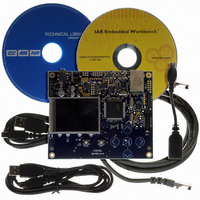ATEVK1105 Atmel, ATEVK1105 Datasheet - Page 327

ATEVK1105
Manufacturer Part Number
ATEVK1105
Description
KIT EVAL FOR AT32UC3A0
Manufacturer
Atmel
Series
AVR®32r
Type
MCUr
Datasheets
1.ATAVRONE-PROBECBL.pdf
(16 pages)
2.ATEVK1104.pdf
(826 pages)
3.ATEVK1105.pdf
(28 pages)
Specifications of ATEVK1105
Contents
Evaluation Board, Software and Documentation
Processor To Be Evaluated
AT32UC3A0512
Processor Series
AVR
Data Bus Width
32 bit
Interface Type
USART, TWI, USB, SPI, Ethernet
Operating Supply Voltage
3.3 V
Silicon Manufacturer
Atmel
Core Architecture
AVR
Core Sub-architecture
AVR UC3
Silicon Core Number
AT32UC3A0512
Silicon Family Name
AVR
Kit Contents
Board CD Docs
Rohs Compliant
Yes
For Use With/related Products
AT32UC3A0
Lead Free Status / RoHS Status
Lead free / RoHS Compliant
- Current page: 327 of 826
- Download datasheet (20Mb)
26.7.5.2
32058J–AVR32–04/11
Protocol T = 0
As the TXD pin becomes bidirectional, its output remains driven by the output of the transmitter
but only when the transmitter is active while its input is directed to the input of the receiver. The
USART is considered as the master of the communication as it generates the clock.
Figure 26-30. Connection of a Smart Card to the USART
When operating in ISO7816, either in T = 0 or T = 1 modes, the character format is fixed. The
configuration is 8 data bits, even parity and 1 or 2 stop bits, regardless of the values pro-
grammed in the CHRL, MODE9, PAR and CHMODE fields. MSBF can be used to transmit LSB
or MSB first. Parity Bit (PAR) can be used to transmit in normal or inverse mode. Refer to
”USART Mode Register” on page 343
The USART cannot operate concurrently in both receiver and transmitter modes as the commu-
nication is unidirectional at a time. It has to be configured according to the required mode by
enabling or disabling either the receiver or the transmitter as desired. Enabling both the receiver
and the transmitter at the same time in ISO7816 mode may lead to unpredictable results.
The ISO7816 specification defines an inverse transmission format. Data bits of the character
must be transmitted on the I/O line at their negative value. The USART does not support this for-
mat and the user has to perform an exclusive OR on the data before writing it in the Transmit
Holding Register (THR) or after reading it in the Receive Holding Register (RHR).
In T = 0 protocol, a character is made up of one start bit, eight data bits, one parity bit and one
guard time, which lasts two bit times. The transmitter shifts out the bits and does not drive the
I/O line during the guard time.
If no parity error is detected, the I/O line remains at 1 during the guard time and the transmitter
can continue with the transmission of the next character, as shown in
If a parity error is detected by the receiver, it drives the I/O line at 0 during the guard time, as
shown in
In this case, the character lasts 1 bit time more, as the guard time length is the same and is
added to the error bit time which lasts 1 bit time.
When the USART is the receiver and it detects an error, it does not load the erroneous character
in the Receive Holding Register (RHR). It appropriately sets the PARE bit in the Status Register
(SR) so that the software can handle the error.
Figure 26-32 on page
USART
TXD
CLK
328. This error bit is also named NACK, for Non Acknowledge.
and
”PAR: Parity Type” on page
CLK
I/O
Smart
Card
Figure 26-31 on page
345.
AT32UC3A
328.
327
Related parts for ATEVK1105
Image
Part Number
Description
Manufacturer
Datasheet
Request
R

Part Number:
Description:
DEV KIT FOR AVR/AVR32
Manufacturer:
Atmel
Datasheet:

Part Number:
Description:
INTERVAL AND WIPE/WASH WIPER CONTROL IC WITH DELAY
Manufacturer:
ATMEL Corporation
Datasheet:

Part Number:
Description:
Low-Voltage Voice-Switched IC for Hands-Free Operation
Manufacturer:
ATMEL Corporation
Datasheet:

Part Number:
Description:
MONOLITHIC INTEGRATED FEATUREPHONE CIRCUIT
Manufacturer:
ATMEL Corporation
Datasheet:

Part Number:
Description:
AM-FM Receiver IC U4255BM-M
Manufacturer:
ATMEL Corporation
Datasheet:

Part Number:
Description:
Monolithic Integrated Feature Phone Circuit
Manufacturer:
ATMEL Corporation
Datasheet:

Part Number:
Description:
Multistandard Video-IF and Quasi Parallel Sound Processing
Manufacturer:
ATMEL Corporation
Datasheet:

Part Number:
Description:
High-performance EE PLD
Manufacturer:
ATMEL Corporation
Datasheet:

Part Number:
Description:
8-bit Flash Microcontroller
Manufacturer:
ATMEL Corporation
Datasheet:

Part Number:
Description:
2-Wire Serial EEPROM
Manufacturer:
ATMEL Corporation
Datasheet:










